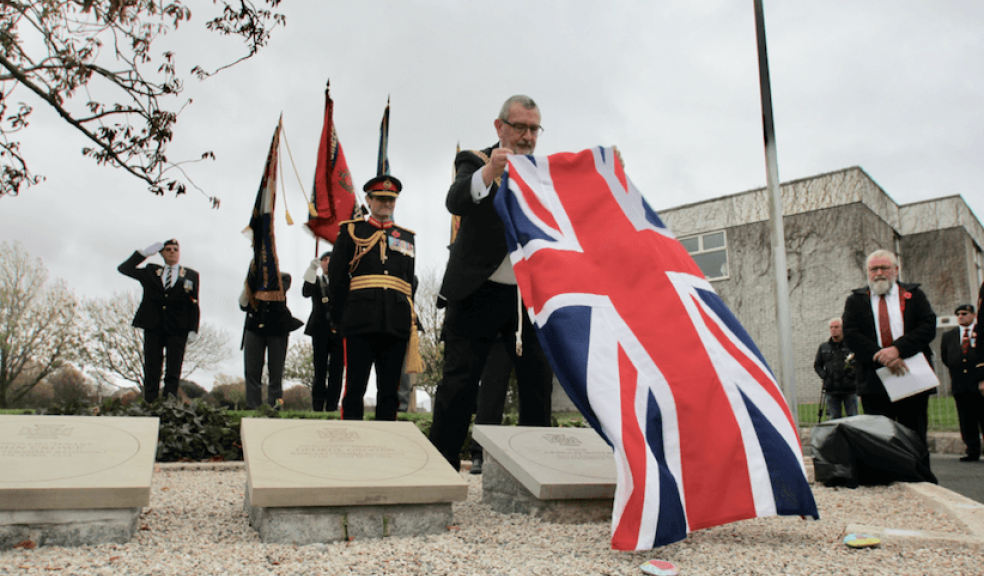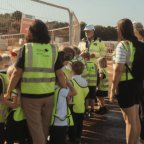
Final Victoria Cross paving slab unveiled to honour First World War hero
The fourth and final commemorative paving slab dedicated to the Plymouth and Devonport-born soldiers, who were awarded the Victoria Cross for their acts of bravery during the First World War, has been unveiled on the Hoe by Lord Mayor, Councillor Sam Davey.
The slab is located at the junction of Citadel Road and Lockyer Street, just down from the Naval War Memorial. It’s in memory of Brigadier Sir Arnold Horace Santo Waters VC, CBE, DSO, MC (23 September 1886 – 22 January 1981).
Arnold was born on Mildmay Street and attended Hoe Grammar School, the son of a long serving minister at the Hope Chapel which was once located on Ebrington Street. He trained locally as an engineer before moving to London in 1906 and qualifying in 1908.
He joined the Royal Engineers in January 1915 and was quickly promoted. During the early months of 1918, and now a Major, he commanded thousands of men at Ypres, Belgium.
He was awarded his Victoria Cross for the bravery he showed on November 4, 1918 whilst in charge of bridging the Oise-Sambre Canal near Ors, in northern France.
The canal was the site of one of the last Allied victories of the First World War. It took place just a week before Armistice and was the battle during which celebrated poet Wilfred Owen was killed. The Royal Engineers were responsible for placing footbridges across the canal to enable the Allied forces to advance.
After the Allies came under heavy machine-gun fire from the Germans, Arnold went forward and supervised the completion of two of the bridges. The success of the operation ‘was due entirely to his valour and example’.
After the war, Arnold settled in Birmingham, married and established a successful engineering business. He was invited to a ‘Freedom Ceremony’ in Plymouth in 1919, where he received an illuminated commendation and a ‘Sword of Honour’. He later served twice as President of the Institution of Structural Engineers (ISE) and received a knighthood in 1954.
Councillor Peter Smith, Deputy Leader said: “Unveiling these slabs during the First World War centenary has enabled us to learn more about some astonishing acts of individual courage, as well as Plymouth and Devonport’s links with the wider story of this major conflict.
“Arnold Waters displayed great bravery in a situation more challenging and dangerous than most of us could imagine. Today was a fitting tribute and it was really touching to see so many of his family here, a number of whom had travelled a great distance to honour their distinguished ancestor.”
Principal guests at the unveiling ceremony included Arnold’s eldest son Tim Waters. Participating guests of honour included Major General Ivan Jones CB, Director Personnel at Army HQ & Hon. Deputy Colonel Comdt., Royal Engineers, and Mr Nick Russell, CEng, FIStructE, FICE, F.ASCE, MCMI, a past President of ISE.
Waters’ slab joins the three others that have been unveiled since the First World War centenary began. As part of the ceremony Nick Russell also unveiled two new information panels, generously sponsored by ISE, which include portraits and short biographies of all four local heroes.
The first slab is dedicated to Sergeant Alfred Joseph Richards who saw action at Gallipoli in 1915. The second and third slabs are dedicated to Captain John James Crowe and George William St. George Grogan, both of whom served on the Western Front in Belgium and France respectively.
The commemorative slabs are part of a national initiative from the Department for Local Communities and Local Government to honour Victoria Cross recipients from the First World War. The slabs have been laid in the birth places of all those awarded the Victoria Cross during the conflict.












